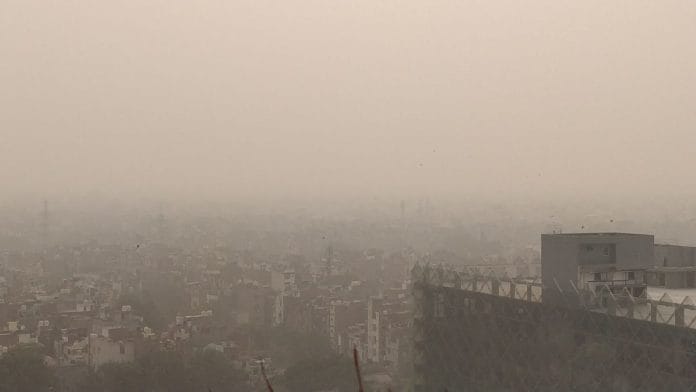New Delhi: Air pollution and high temperatures are some of the leading causes for stroke incidence and prevalence worldwide. A new report published online last week in the journal The Lancet Neurology looks at data from 1990 to 2021 to assess the occurrence, causes, risk factors and regional variations of stroke deaths across 204 countries.
The study is an analysis of the latest Global Burden of Disease (GBD) Study, published in 2021. Led by neurologist Valery L Feigin, director of the Auckland University of Technology in New Zealand, it will appear in volume 23, issue 10 of the journal in October.
South Asia, along with Latin America, Central Asia, and Africa, is one of the top regions where ambient air pollution is a high-risk factor for stroke-related deaths and disabilities.
Similarly, stroke-related deaths and disabilities attributed to other risk factors such as household air pollution from solid fuels, too, have higher presence in South Asia as opposed to Western Europe or North America. Through these analyses, the study describes how strokes and their related causes differ across regions.
One of the most important trends noticed by this analysis is that after high systolic blood pressure, ambient air pollution was the second-highest risk factor for stroke-related deaths and disabilities worldwide. It was responsible for 16.6 percent of stroke disability-adjusted life years (DALYs), more than smoking, which was at 13.3 percent.
“Consistent with previous studies, this study showed disparities in stroke burden and risk factors by GBD region, country, country income level, and SDI quintiles,” the study reads. SDI stands for socio-demographic index.
In 2021, there were a total of 11.9 million new strokes in the world, the study says.
It adds that there was an increase of 14.8 percent in the prevalence of strokes in people younger than 70. The increasing number of stroke causes and incidences, all led the University of Washington’s Institute for Health Metrics and Evaluation (IHME)—the organisation that conducts the GBD study—to look critically at stroke risk factors and prevention methods.
The report is a time-series analysis using the most comprehensive database of health and disease trends worldwide—the GBD. It builds off of the fact that in 2021, strokes were the third-highest cause of death, after only coronary heart disease and COVID-19, and was the fourth-highest cause of disability in the world.
However, this study, written by a group of international scholars, aims to go beyond global numbers and look at specific risk factors and their prevalence in world regions, divided by income levels and development levels.
In the same beat, the study talks about how between 1990 and 2021, the number of stroke-related deaths and disabilities due to high ambient temperature increased by 72 percent. This was the second-highest increase in any risk factor, the highest increase being seen in high Body Mass Index (BMI). High ambient temperature, however, is the highest risk factor in the ‘environmental risks’ bracket.
Preventable stroke risk factors
Both the study and a statement by the IHME talk about the fact that strokes are a largely preventable disease. The study itself focuses on identifying different clusters of risk factors for strokes—from environmental risks, such as temperature and ambient air pollution, to dietary risks, such as high-sodium diets or low-fruit consumption.
By assessing which risks are more responsible for causing strokes and stroke DALYs, and where they are prevalent, the study aims to aid “effective, accessible, and affordable measures to improve stroke surveillance, prevention, acute care, and rehabilitation.”
The study finds that more than 75 percent of stroke prevalence, and 83 percent of stroke incidence in 2021, took place in low- and middle-income countries (LMICs). Additionally, 87 percent of fatal strokes and 89 percent of stroke-related disabilities and premature deaths also happened in LMICs.
Other studies on effect of air pollution on strokes
The effect of air pollution on strokes had been studied before, and was first brought to light in 2016 by the same IHME GBD team.
Even in New Delhi, a small-scale study conducted in 2021 found that an increase in PM2.5 (particulate matter with size less than 2.5 micrometres) levels leads to an “increase in the recurrent incidence of strokes”.
Larger studies conducted in Poland and other countries show that exposure to high particulate matter concentration in the air leads to an increase in the incidence of strokes during winters, for average age groups of 70.
Since ambient air pollution and high temperatures are linked to anthropogenic actions and can be acted upon, similar to dietary preferences, the study suggests that almost 84 percent of stroke risk factors are ‘modifiable.’
This means that strokes are likely to be preventable if measures are taken both at an individual and national/global level to address high-risk factors like air pollution now.
“Given that ambient air pollution is reciprocally linked with ambient temperature and climate change, the importance of urgent climate actions and measures to reduce air pollution cannot be overestimated,” Dr Catherine O. Johnson, lead research scientist at IHME and co-author on the paper, said in the IHME statement.
(Edited by Radifah Kabir)
Also Read: India just saw 2nd hottest June-August period since 1970, 426 million exposed to week of risky heat






